
Status of Solid Waste Disposal and GEP ECOTECH Intelligent Environmental Protection Solutions
2025-03-19With the acceleration of urbanization worldwide, solid waste management has become a significant challenge for countries. Taking the Philippines as an example, its solid waste generation has seen a marked increase in recent years, and is projected to reach approximately 36 million tons by 2025. However, currently, less than half of the waste is properly treated, with the remainder mostly being disposed of in open dumps or burned. The country also faces low recycling rates, as well as issues related to insufficient technological innovation and limited funding in the solid waste management sector.Against this backdrop, the global solid waste management industry is facing new opportunities for development, with technological innovation being the key to driving industry growth. GEP ECOTECH, with its advanced technologies and solutions, is committed to providing efficient and environmentally friendly solid waste management services to customers worldwide.GEP ECOTECH Intelligent Environmental Protection Solid
In the modern era of waste management and material processing, the double shaft shredder with high torque stands out as a pivotal innovation. Engineered for robustness and efficiency, this shredding solution is designed to tackle the most challenging materials, transforming bulky and difficult-to-process waste into manageable sizes. This article delves into the mechanics, applications, and advantages of high-torque double shaft shredders, highlighting their role in enhancing recycling and waste management processes.The Mechanics Behind High-Torque Double Shaft ShreddersAt the heart of the high-torque double shaft shredder lies a powerful drive mechanism that generates significant torque at low speeds. This design principle ensures the efficient breakdown of materials without the risk of jamming or excessive wear on the components. Equipped with two counter-rotating shafts fitted with cutting blades, the shredder can process a wide variety of materials with precision and ease. The high torque output allows
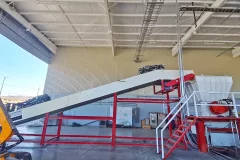

With the rapid growth of urbanization and the increase in population, the issue of waste management has become a daunting task. In order to tackle this challenge, the use of advanced equipment such as shredders, magnetic separators, and wind sifters has become increasingly prevalent.Shredders, for instance, are a critical component of any waste management process. They are used to reduce the size of waste materials, making transportation and subsequent disposal easier and more efficient. In addition, shredders can be used to destroy confidential documents, protecting sensitive information from falling into the wrong hands.Another essential piece of equipment is the magnetic separator, which is utilized to remove metallic materials from waste streams. With the ever-increasing amount of electronic waste being generated, this technology has become crucial in ensuring that valuable metals are not lost and are instead recovered for reuse.Wind sifters are also frequently used in the waste management process. They

Plastic waste management has become a significant environmental concern globally. Sorting plastic waste effectively is crucial to promote recycling and minimize pollution. This article aims to provide an optimized approach for utilizing a trommel screen to separate organic residue contaminants from plastic waste. The trommel screen, a cylindrical device with various-sized openings, can facilitate efficient separation while minimizing contamination.Proper Trommel Screen Sizing:To optimize the separation process, it is essential to select an appropriate trommel screen size. The trommel screen's length, diameter, and the size of the openings should correspond with the specific plastic waste composition and the targeted organic residue contaminants. Conduct thorough analysis and consider the particle size distribution of the waste to determine the optimal screen parameters.Pre-Screening and Sorting:Before introducing the plastic waste into the trommel screen, it is advisable to pre-screen and sort the waste


Waste Management with Single-Shaft Shredders
2023-08-27In today's world, efficient waste management has become a pressing concern. As the amount of household waste continues to rise, it is crucial to explore innovative solutions for its proper disposal. One such solution is the utilization of single-shaft shredders, which play a significant role in processing and managing household waste effectively. This article aims to highlight the benefits and optimization of using single-shaft shredders in the context of handling domestic waste. Enhanced Waste Reduction:Single-shaft shredders excel at reducing the size of various waste materials, including plastics, paper, textiles, and organic waste. By shredding waste into smaller pieces, these machines facilitate the efficient sorting and separation of different recyclable materials. This process significantly contributes to waste reduction, allowing for increased recycling rates and reducing the strain on landfills.Automated and Versatile Operation:Single-shaft shredders are designed with automation in mind, offering a

Waste management in developing countries can pose a significant challenge, due to the lack of proper infrastructure and resources. The same is true for the Kingdom of Cambodia, where waste disposal is a growing concern, especially in urban areas. One of the effective solutions to this problem is using shredders for processing household waste. In this article, we will discuss the benefits and challenges of using shredders in Cambodia.Benefits of Shredders for Waste ManagementVolume Reduction: One of the primary benefits of using shredders for waste management is volume reduction. Shredding enables the waste to be compacted, thereby reducing the overall volume of waste, which in turn, makes it easier to transport and dispose of.Landfill Space Optimization: With the help of shredders, the waste can be effectively segmented into various categories such as organic, plastic, metal, etc. This way, the non-biodegradable waste can be separated and, in turn, landfills can be optimized to avoid unnecessary waste

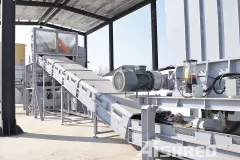
With a population of over 69 million people, Thailand generates a significant amount of domestic waste every day. The improper disposal of this waste can lead to various environmental and health problems, which is why effective waste management systems are crucial.One solution that has gained popularity in recent years is the use of waste shredders. These machines can reduce the volume of solid waste by up to 90%, making it easier and more cost-effective to transport and dispose of. In addition, shredded waste can be recycled or reused in various ways, such as for composting or as a source of energy. Several models of waste shredders are available in the market, ranging from small household units to industrial-scale machines. They come equipped with powerful motors and sharp blades that can shred all sorts of waste, including plastics, paper, cardboard, and even metal cans.In Thailand, waste shredders are becoming increasingly common in both residential and commercial settings. Many households and businesses

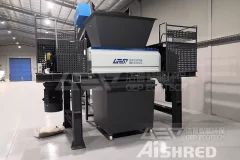
How to Deal with Paper Mill Waste?
2023-02-22Do you know how the paper we use every day is produced? Whether it is office paper, living paper, corrugated paper boxes, etc., paper is really important in our life. Traditional paper is produced from pulp. However, with the deepening of environmental protection concepts and the promotion of environmental protection policies, recycled paper has been slowly replacing traditional pulp paper. The rise of recycled paper has great significance for environmental protection and resource recovery. However, in the process of recycled paper making, a large amount of paper mill waste will be produced. According to statistics, the paper mill waste produced by a recycled paper mill accounts for about 12% of the recycled paper production. For example, a recycled paper mill with an annual output of 1 million tons will produce about 120 thousand tons of paper mill waste every year. If these paper mill residues are not properly treated, they will have a great impact on the environment, thus losing the significance of the


Modern society has a huge demand for paper. In recent years, as environmental protection efforts have increased, traditional pulp and paper making has been greatly reduced and replaced by more environmentally friendly recycled paper making. However, due to the different ways and quality of waste paper recycling, recycled waste paper may be mixed with other impurities, resulting in a large amount of solid waste in the manufacturing process of recycled paper, also known as "recycled paper sludge". Paper waste can be divided into two categories: coarse material and fine material. Coarse material mainly from the pulping and slagging stage, mostly stranded rope; fine material mainly from the cleaning and screening stage, fine material can be divided into light slag and heavy slag. After a reasonable process, most of the screened slag can be made into SRF fuel, which is used for incineration and power generation. The waste shredding and processing system of environmental friendly paper mill adopts cutting-edge

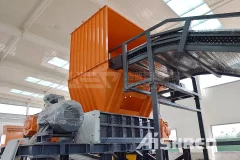
Solid waste disposal centre, generally refers to the decoration waste crushing disposal, construction and demolition waste disposal, bulky waste disposal centre, bulky waste shredder plays an irreplaceable role in it. Whether it is construction and demolition waste or renovation waste, there will be a lot of materials belonging to the large piece of waste put together, like sponge cushions, packaging, carpets, plastic and other light materials, these materials through the disposal of large piece of waste shredder, can achieve a greater degree of capacity reduction. For this reason ,AIShred has launched the GDL series of bulky waste shredders, a highly productive shredding and capacity reduction machine developed specifically for the bulky waste industry. The GDL series is designed with low speed and high torque, and is CE certified, featuring high shear force, good shredding effect, low noise and high stability. The equipment is mainly used for the shredding and disposal of waste mattresses, sofas, tables

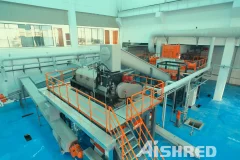
MSW Disposal Equipment for sale
2023-02-04MSW (municipal solid waste) disposal is divided into two forms: General pretreatment and resource utilization. For example, each waste transfer station only needs crushers and magnetic separators if it only provides waste pretreatment and transfer to the centralized Center for resource utilization. First, the domestic waste is crushed into smaller particles by the domestic waste shredder for convenient storage and transportation, and then the ferrous metals are magnetically separated, so that the processed materials can be packed and transported. It is efficient and convenient, and is very suitable for small and medium-sized waste treatment plants to pretreat the collected domestic waste and transfer it. If we want to make deep resource utilization of domestic waste, we need more sorting equipment. For example, domestic waste crushers are also divided into coarse crushers and fine crushers. After coarse crushing, roller screens are used for coarse screening to separate small pieces of heavy materials such as


At present, there are three main treatment methods for municipal solid waste(MSW): landfill, composting and incineration. Landfilling usually involves burying domestic waste directly underground to allow them to decompose naturally; The composting method requires the use of equipment to break the organic matter in the domestic waste, and then explain the organic matter to make compost; Incineration is the process of crushing and sorting domestic waste, or directly burning it for power generation, or making it into RDF combustion rod, which is basically thermal energy conversion. These three methods are widely used at present, and each has its advantages and disadvantages. Landfill occupies land resources, composting process is complex, and incineration needs to strengthen flue gas treatment. At present, there are more environmentally friendly new technologies, such as hydrogen production from domestic waste. No matter which of the above domestic waste treatment methods is used, it is for the purpose of


In waste management and recycling applications, permanent stationary equipment is used in most cases, but in some special areas movable machines are being used. For example, in temporary waste dumps and demolition sites, mobile shredder and crusher plants are widely used due to their good passability and mobility. For small processing needs, some enterprises or individuals are accustomed to renting mobile equipment for temporary processing. Leasing companies have seen these business opportunities and are also looking for high-quality mobile shredders/crushers. As a industrial shredder and crusher manufacturer, AIShred can supply mobile versions based on all of our existing machines. They can be within a steel frame(compact version) or mounted on tire or tracked frames. AIShred mobile crushers and shredders can handle almost all solid waste, from waste wood to scrap metal, garden waste, municipal solid waste, industrial waste, construction and demolition waste. They can work individually or together to


Solid & Bulky Waste Shredder Machine
2022-07-25Due to the large volume and inconvenient transportation of solid, bulky waste, it is often necessary to reduce the volume and quantity of bulky waste in the process of resource recycling, and then recycle and reuse the materials according to different material properties and needs. A recycling company from Europe purchased a set of bulky waste shredder machine from our company, including related chain plate conveyor, belt conveyor, intelligent control system and other equipment, in order to achieve the purpose of resource recycling and reuse of bulky waste. Now let's learn about some related issues of large waste disposal. Definition of Bulky WasteLarge waste refers to solid items that are large in volume and strong in integrity and need to be separated and reprocessed. Including waste household appliances (waste refrigerators, washing machines, televisions, etc.) and furniture (such as sofas, mattresses, cabinets, etc.).Disposal Process of Bulky Waste Resource RecyclingThe bulky waste shredder uses the


Hammer Mills for Waste and Recycling
2022-06-18A hammermill is a common type of equipment currently used for size reduction of solid waste. A hammermill consists of a central rotor or shaft with radial arms (hammers) protruding from the rotor circumference. The rotor is enclosed in a heavy duty housing, which may be lined with abrasion resistant steel members. Some hammermilIs may also have stationary breaker plates or cutter bars mounted inside the housing. Input material is reduced in size by impact, attrition, and shearing forces induced by the hammers. There are two basic types of hammermiIls: the horizontal shaft type and vertical shaft type. The horizontal shaft hammermill is the more common type. As the name implies, the rotor or shaft is horizontal and supported on each end. Input is usually at the top and material flows through the machine assisted by gravity. Force feed at the side of the hammermill has also been used for solid waste shredding. Most horizontal hammermiIls have a grate placed across the output opening. Input material cannot pass
Het Pulper for Solid Waste Management
2022-06-17A wet pulper is similar in design and operation to a common household blender. In operation, a slurry of about 90 percent water and 10 percent solid waste is placed in the pulper. The interior of the pul per may be lined with protruding hardened impact pins, but often the interior is a smooth surface. A central rotating element (either a disk or a set of blades) spins at high speed (peripheral speed of 5,000 ft/min) forming a vortex or whirlpool in the siurry. Repeated impact of the solids with the rotating element reduces the solid waste to a pulp. Unpulpable iterns, such as rubber tires are bal1istically rejected. Wet pulpers can operate as a batch process or a continuous process. After pulping, the slurry is removed from the pulper; and the majority of the water is removed by squeezing and is reused. The wet pulper and dry shredding system are not generally interchangeable in application. The wet system requires extensive auxiliary equipment for addition and removal of water and this equipment is not


Size Reduction of Municipal Solid Waste
2022-06-16Size reduction is defined as operations or processes which reduce the size of influent materials through division into two or more subunits. Size reduction of municipal solid wastes (often called shredding, grinding, or pulverizing) is a new concept, and much of the technology has been borrowed from the mining and rock-crushing industry. Because solid waste is a heterogeneous mixture(unlike rock), much of the technology is not directly transferable; and size reduction of solid waste has not always been efficient; however,as more solid waste systems have been built, the technoloqy of solid waste size reduction has been sianificantly advanced. More than 2.01 billion tonnes of municipal solid waste are produced annually worldwide. Land areas suitable for land disposal near urban areas where the bulk of the solid waste is generated are becoming scarce and expensive. Open burning and open dumping have been outlawed in many areas because of pollution and health hazards. Incineration is becoming increasingly more
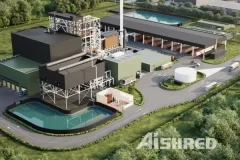
Energy Recovery from Municipal Solid Waste
2022-06-06Municipal Solid Waste (MSW) contains organic as well as inorganic matter. The latent energy present in its organic fraction can be recovered for gainful utilisation through adoption of suitable Waste Processing and Treatment technologies. The recovery of energy from wastes also offers a few additional benefits as follows:The total quantity of waste gets reduced by nearly 60% to over 90%, depending upon the waste composition and the adopted technologyDemand for land, which is already scarce in cities, for landfilling is reducedThe cost of transportation of waste to far-away landfill sites also gets reduced proportionatelyNet reduction in environmental pollutionEnergy can be recovered from the organic fraction of waste (biodegradable as well as non-biodegradable) basically through two methods as follows:Thermo-chemical conversion: This process entails thermal de-composition of organic matter to produce either heat energy or fuel oil or gas;Bio-chemical conversion: This process is based on enzymatic

Biomedical Waste Harmless Treatment Methods
2022-06-05Biomedical waste originates from human or animal health care, medical research, medical teaching facilities, laboratories and other facilities. A portion of that waste stream is infectious or potentially infectious and presents a potential hazard to the public health and the environment. Before biomedical waste is recycled or landfilled, it must be treated in a harmless manner, and toxic and infectious materials must be thoroughly sterilized. Generally speaking, the harmless treatment of medical waste includes the following methods:IncinerationThis is a high temperature thermal process employing combustion of the waste under controlled condition for converting them into inert material and gases. Incinerators can be oil fired or electrically powered or a combination thereof. Broadly, three types of incinerators are used for hospital waste : multiple hearth type, rotary kiln and controlled air types. All the types can have primary and secondary combustion chambers to ensure optimal combustion. Incineration has

Municipal Solid Waste Recycling Methods
2022-06-04Biological or thermal treatment of municipal solid waste can result in recovery of useful products such as compost or energy.Biological ProcessesBiological treatment involves using micro-organisms to decompose the biodegradable components of waste. Two types of processes are used, namely:Aerobic processes: Windrow composting, aerated static pile composting and in-vessel composting; vermi-culture etc.Anaerobic processes: Low-solids anaerobic digestion (wet process), highsolids anaerobic digestion (dry process) and combined processesIn the aerobic process the utilisable product is compost. In the anaerobic process the utilisable product is methane gas (for energy recovery). Both processes have been used for waste processing in different countries – a majority of the biological treatment process adopted world-wide are aerobic composting; the use of anaerobic treatment has been more limited.Thermal ProcessesThermal treatment involves conversion of waste into gaseous, liquid and solid conversion products with

Solid Waste Sorting Plant Introduction
2022-06-03Sorting is carried out to segregate the waste into different streams to fulfil one or more of the objectives listed above. Accordingly the waste should be divided into the following streams:Dry RecyclablesConstruction and demolition wasteBiodegradable wasteBulky WasteHazardous wasteMixed MSW (often referred to as comingled waste)Waste Sorting PlantMixed waste should be sorted into the various streams either at a transfer station or at a centralised sorting facility. If this is not feasible, mixed waste can be sent to a waste processing facility which has a well designed pre-sorting/post-sorting facility where the mixed waste can be sorted into separate streams. Mixed waste not found suitable for processing should be landfilled.Waste Sorting Plant ProcessSorting can be carried out manually or through semi-mechanised and fully mechanised systems.Manual Sortingunloading the wastemanually (with protective measures) spreading the wastehand picking (with protective measures) visually identifiable waste for


Construction and Demolition Waste Recycling
2022-06-02Construction and demolition (C&D) waste generally constitutes about 10%–20% of total urban solid waste, it includes bricks, tiles, stone, soil, rubble, plaster, drywall or gypsum board, wood, plumbing fixtures, non-hazardous insulating material, plastics, wall paper, glass, metal (e.g., steel, aluminium), asphalt, etc. C&D and other inert waste may be utilised for making bricks, pavement blocks, construction materials such as aggregates etc.The use of C&D waste will minimise the cost of managing such waste and requirement for valuable landfill space, and also save natural resources and reduce the use of virgin soil. Benefits of Processing C&D WasteC&D waste can be put to a profitable use, given the scarcity of sand and stone for construction, thereby saving natural resources.It prevents public nuisance and traffic congestion issues arising from indiscriminate dumping of C&D waste.It saves valuable space at landfill sites.It reduces cost of bulk transportation if recycled close to source of generation.C&D


Solid Waste to Engineered Fuel Solution
2022-05-27Engineered fuel is a kind of alternative fuel produced by processing and blending construction and demolition material, and/or select industrial and/or commercial byproduct material streams including: plastic, paper, paper mill contraries, paper fiber, cardboard, textiles, carpet, and rubber.Waste to Engineered Fuel Processingpre-screening of potential customers' material before it is received;feedstock acceptance practices to ensure a primarily wood-based product and removal of materials that may have high contaminant levels;removal of metals and fines;manual sorting to remove residual contaminated material;shredding to improve the fuel characteristics of the material;final screening to ensure consistency and low ash levels and improved combustion in the fuel.GEP ECOTECH Shredding Solution in Waste-to-Fuel ApplicationShredding is the most important stage in Waste-to-Fuel applications, as it imporve the fuel characteristics. GEP ECOTECH offers two kind of shredders for waste to engineered fuel application:


Scrap Tires to TDF with AIShred Shredders
2022-05-26Waste tires have great value and can turn them into alternative fuels used in cement kilns, power plants, steel mills, called TDF(Tire Derived Fuel), which reduces threats from unlawful stockpiling, while also creating economic profits. How is TDF produced?In simple terms, processing of discarded scrap tires into TDF consists of three main steps: shredding, screening and metal removal. The level of each is determined by the end user's needs and specifications (i.e., size of shreds and amount of metal removed). For shredding of scrap tires, equipment for tire processing generally comes in two types - slow speed and high-speed shredder. Slow speed shredder or rotary shear shredder is used to produce the larger chip sizes suitable for applications such as cement kilns, shearing the tire into 2 to 5-inch size shreds and liberating between 2 and 10 percent of the bead wire contained within the tire. The high speed single shaft shredder contains a rotor equipped with knives that shred the tire until they are of



